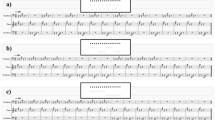Abstract
Quantitative EEG mapping in powers of electrical activity, concentration of main powers and area of concentration in relation to the side of presentation (left, right, and bihemisphery) and closer location was done on a 24-day-old infant first, and again when the infant was 2.5 months. EEG responses are analyzed in following acoustic modalities: (1) specific (native language speech of mother and unfamiliar female, unfamiliar female speech of foreign language); (2) unspecific (passive period). Familiar and unfamiliar texts present the contents of speech material. Comparative findings on two different ages showed that the infant maintains the processing scheme of unfamiliar stimulus (passive period, foreign language), and also very similar processing scheme of unfamiliar voice regardless if the text in native language is familiar or unfamiliar. During stimulation with familiar or unfamiliar text in native language, which is read by mother, processing type is significantly changed in relation to the age at the time of examination. While a 24-day-old infant shows a similar scheme in processing the familiar and the unfamiliar voices in native language, at the age of 2.5 months, this scheme of processing is changed, especially for theta rhythm, which now has bihemisphery presentation (at earlier stage it has right-side presentation) in the F–C–P region, what is practically the same region where also delta rhythm is processed. However, the sample of unfamiliar voice in native language observed in subsequent period, when the infant was 2.5 months old, maintains the same processing location as it has at an earlier ontogenetic stage, when the infant was 24 days old, regarding the theta rhythm processed in the F–C–P region with right-side presentation, and delta rhythm processed in C–P region with bihemisphery presentation. Post stimuli periods observed when the infant was 2.5 months old show obviously differentiation of theta and delta rhythms’ samples and their electrophysiological parameters. The samples of familiar and unfamiliar texts in native language when read by mother (familiar voice) begin to differentiate regarding to closer location and number of centers for maximal powers in theta rhythm at subsequent ontogenetic period (2.5-month-old infant). The samples of quantitative EEG mapping for a 2.5-months-old infant show the signs of complex processing of different stimuli types: known/unknown voice, foreign language, with stronger inclusion of parietal regions, bihemisphery and an increase in number of maximal powers' centers, compared to the samples when the infant was 42 days old. Quantitative EEG electrophysiological parameters are discussed in relation to side representation and closer regional location with the aim of explaining the processing of complex speech and language stimulation in relation to certain characteristics in its bases.
Similar content being viewed by others
References
Farber DA (1993) Principles of structural and functional brain organization in ontogenesis: main stages of its formation. In: Farber R, Njiokiktjien (eds) Pediatric behavioral neurology: developing brain and cognition, vol 4. Suyi Publication, Amsterdam, pp 156–169
Harter MK, Aine CJ (1985) Brain mechanisms of selective attention. In: Parasuraman R, Davies D (eds) Varieties of attention. Academic, London, pp 293–321
Petsche H. (1996) Prefrontal coherence: an indicator of working memory. The 8th world congress of IOP, Tampere, Finland, pp 10–11
Wackerman Y (1998) Multichannel EEG complexity and other global measures in studies of brain functions. Inter J Psychophys 30(1–2):23–24
Radicevic Z, Radicevic V, Sovilj M (1999) The processing of verbal statement expressed through the powers and amplitude of EEG rhythms. Speech and language in 3rd Millennium: 1st international interdisciplinary conference on fundamental and applied aspects of speech and language, Belgrade, 1999
Author information
Authors and Affiliations
Corresponding author
Rights and permissions
About this article
Cite this article
Radicevic, Z., Vujovic, M., Jelicic, L. et al. Comparative findings of voice and speech: language processing at an early ontogenetic age in quantitative EEG mapping. Exp Brain Res 184, 529–532 (2008). https://doi.org/10.1007/s00221-007-1119-5
Received:
Accepted:
Published:
Issue Date:
DOI: https://doi.org/10.1007/s00221-007-1119-5




